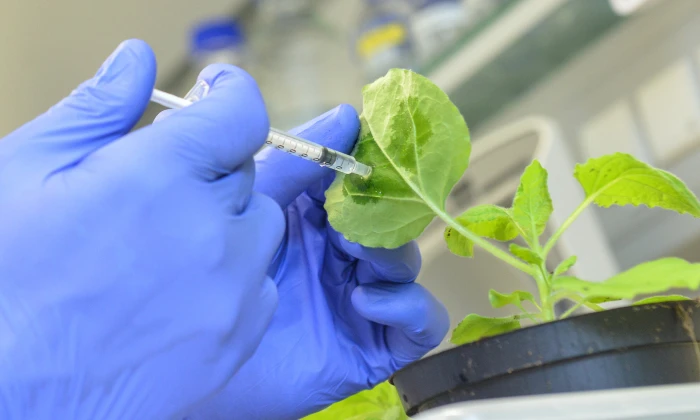Imagine a future where field crops can be vaccinated against diseases and pests. Envision on-farm robots injecting each plant with tiny doses of vaccines, making them resilient to the latest threats.
Furthermore, picture a method to quickly deliver nutrients to growing fruits, vegetables, herbs, and spices through a simple jab.
This futuristic vision is becoming a possibility thanks to a group of biomaterial scientists and engineers who have developed the first-ever microneedle-based drug delivery technique for plants.
Published in the journal Advanced Materials, their groundbreaking research showcases how small compounds can be administered to a wide range of plants, while closely monitoring plant response through biomaterial injection.
Over the course of approximately a year and a half, researchers from Singapore and Cambridge, Massachusetts, extensively tested the silk microneedles using GA3, a commonly used plant growth regulator in agriculture.
Through genetic analysis, the team closely observed the reactions of various crops such as tomatoes, lettuce, spinach, rice, corn, barley, and soybeans.
The results confirmed the effectiveness of the method, highlighting minimal scar and callus formation.
Benedetto Marelli, a corresponding author of the paper and associate professor at the Massachusetts Institute of Technology (MIT), explained that the motivation behind the microneedle technology research was to offer farmers a sustainable and environmentally friendly alternative to spraying.
He emphasized the need for the agricultural sector to adapt and stay resilient in the face of climate change.
Traditional spraying methods, while scalable, can have harmful effects on farmers and the environment.
The particles can be released into the air or soil, percolate into the aquifer, and eventually contaminate water streams.
Marelli pointed out that when sprays are used, only 50 to 90 percent of the application actually reaches the plant tissue, with the rest being wasted or dispersed elsewhere.
The microneedle technology presents a promising solution by providing precise and targeted delivery directly to the plant tissue, minimizing waste and maximizing efficacy.
Additionally, the biodegradable nature of silk, the material used to make the needles, further contributes to its sustainability.
Although the microneedles can be considered a form of plant vaccine, they differ from the syringes used in medical settings.
More To Discover
- Superpowered Supercrystal Can Harness Sunlight For Enhanced Solar Energy and Hydrogen Production Using Nanotech
- U.S. Launches First Car-Ready E-Fuel With 1 Billion Liters in Production
- 9 Trailblazers of Mycelium-Based Meats: 8 Young Fungi Brands You Can Eat Right Now And Their Godfather
- Scientists Are Making Transparent Wood And Here’s Why
To create the needles, the research team mixed functional compounds, such as GA3, into a silk fibroin solution.
The mixture was then cast into a mold to dry and form the microneedles. Using tweezers, the needles were carefully pierced into the plant tissue, releasing the compound directly inside the plant.
Yunteng Cao, the first author of the paper and postdoc researcher at MIT, highlighted the potential impact of the technology, particularly in combating citrus greening disease.
This devastating disease has severely affected the orange industry, particularly in Florida, leading to annual revenue losses exceeding $1 billion and the loss of thousands of jobs each year.
Current methods, such as spraying trees with antibiotics, have proven largely ineffective due to the limited absorption of the drugs into the plant’s system.
Cao sees microneedles as a promising tool to address this issue and ensure global food security, expressing hope and excitement for the meaningful impacts their work can have.
The researchers believe that microneedles can also be used to design new crop traits, in addition to delivering drugs and other inputs. To further advance the project, they plan to conduct trials on different plants at various stages of their life cycles.
Additionally, they aim to attract business partners interested in manufacturing the technology and bringing it to the commercial market.
With these steps in mind, the researchers hope to make the technology available to farmers within the next seven years, revolutionizing crop protection and contributing to a more sustainable and efficient agricultural system.




















